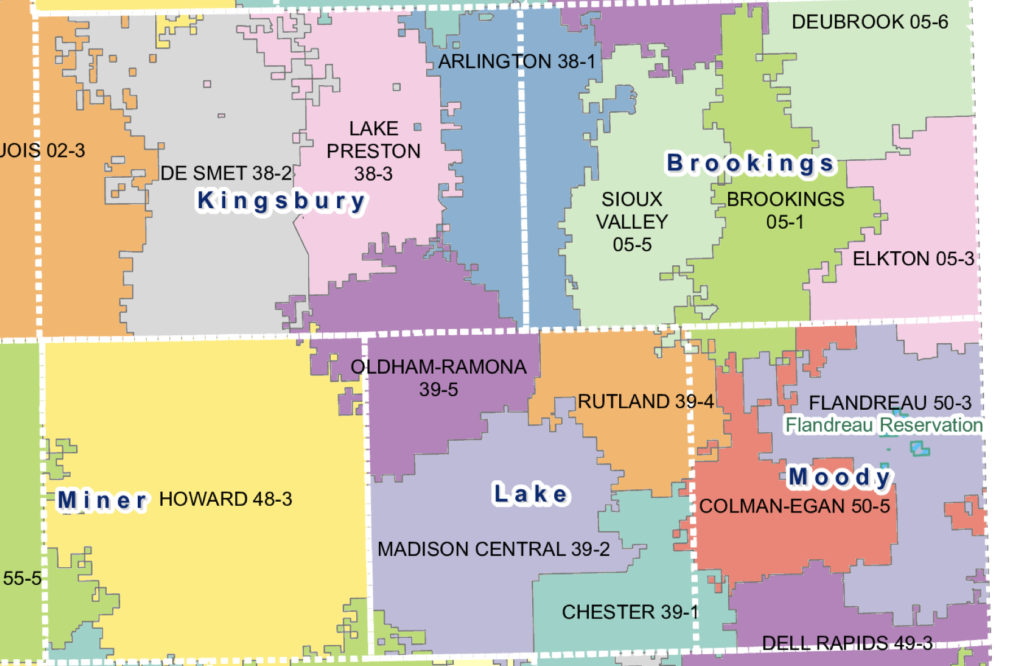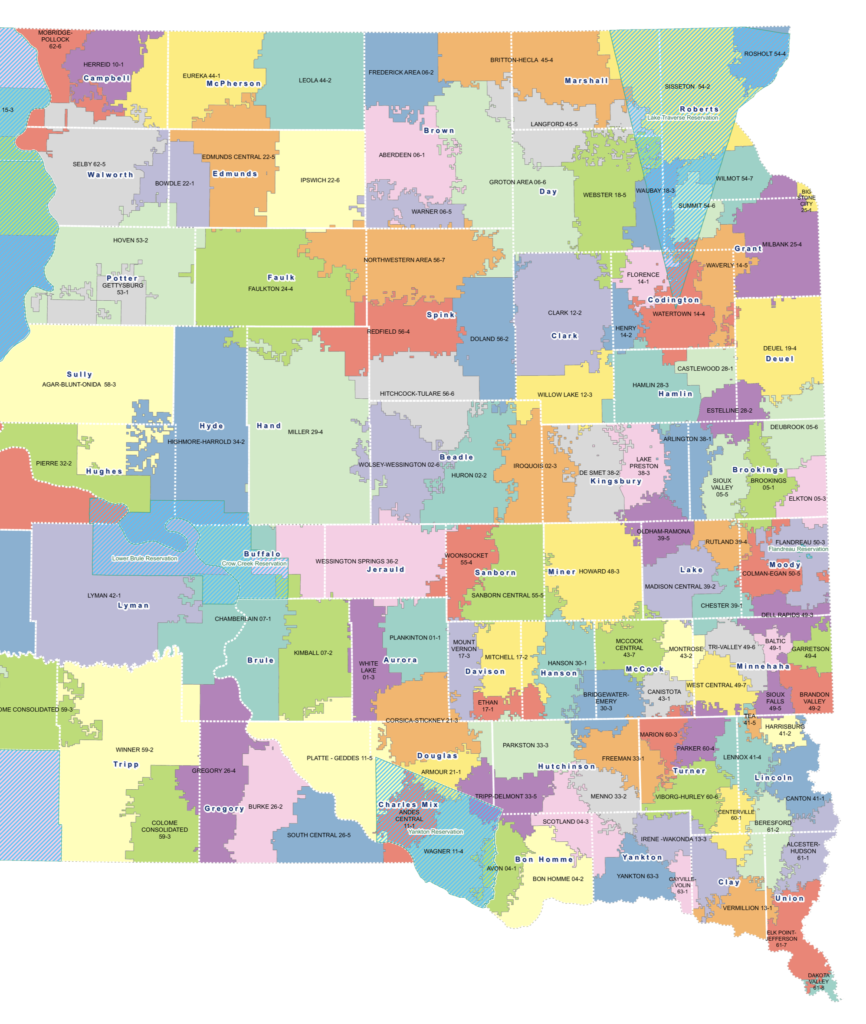The number of school districts in South Dakota will decrease by at least one in 2023. In a special election Tuesday, voters in the Oldham-Ramona and Rutland school districts approved consolidating their districts. The vote was 143 for and 117 against in Oldham-Ramona and 124 for and 117 against in Rutland. Consolidation requires majority approval from each participant district, so had just four people in Rutland changed their minds from yea to nay, or if just eight naysayers among the 215 registered Rutland voters who stayed home had come to the polls, consolidation would have failed. Turnout in Rutland was 53%; turnout in Oldham-Ramona was 49%.
According to information presented at a public meeting in April, voters will elect a new consolidated ORR school board in November, and the districts will officially combine on July 1, 2023, forming a bow-tie-shaped district spanning northern Lake County and reaching into southeastern Kingsbury County, northeastern Miner County, and western Moody County. The new consolidated district will cover 317.35 square miles, just a bit above the current median South Dakota school district area of 311.85 square miles.

The combining districts plan to build a new K-12 school right on the knot of the bow tie, along but safely set back from Highway 81. Logical locations would be the US 81 intersections with the Nunda oil (223rd St) or the Ramona road (225th St), but it’s up to the new consolidated school board to pick a location and call for the bond vote necessary to raise the funds to build a single building for the entire district. If voters approve the bond, the new district would have all students under one roof in time for the beginning of the 2025–2026 school year.
In November, Mike Siefker of the Kingsbury Journal reported that the consolidation could bring the districts’ combined operational costs down from $4 million to $3 million. According to district data updated by the DOE in December 2021, Rutland was paying 21.34 certified instruction FTEs an average salary of $38,399, the lowest average teacher salary of all South Dakota districts. Oldham-Ramona was paying 19.00 certified instruction FTEs $41,390, the fifth-lowest average teacher pay in South Dakota. The student to staff ratio in Rutland was 8.2; in Oldham-Ramona, 8.5. The new ORR district will have a combined K-12 enrollment around 330. School districts of comparable enrollment—Castlewood, Howard, Viborg-Hurley, Bridgewater-Emery, Alcester-Hudson, Kimball, Warner, Freeman—average around 13 students per staff. Applying that ratio to the new ORR district would reduce the certified instructional FTEs by 14, to 26. (That’s 14 full-time teaching jobs disappearing from the Oldham-Ramona-Rutland-Arlington-Madison metroplex.) Reduce the amount the districts are spending on teacher salaries by the same 25% savings factor cited for overall operational costs, and the combined district could spend $1.2 million on that slimmed-down staff, raising the average teacher pay in the new district to $46,460, above the median pay among all South Dakota school districts of $46,160.
Over the past 20 years, 43 districts have consolidated into 24 new combinations; the most recent consolidations were Corsica and Stickney in 2016 and Hurley and Viborg in 2013. Nine districts have dissolved since 2000; the most recent was Grant-Deuel in 2018. South Dakota gained one school district in 2004 when Tea split off from Lennox.
Since the great reorganization of the school systems in the 1960s and 1970s, the number of school districts in South Dakota has declined from 196 in AY 1977 to 149 today. If Oldham-Ramona and Rutland voters can finally accede to practicality to bring that number down to 148, a look at the map should invite us to wonder who will tie the next consolidation knot: Florence and Henry? Leola and Frederick? Marion and Parker? Gregory and Burke?

Well at least those students will be used to traveling to work on the subway when they leave South Dakota for a real job. The girls will get their rights back as women too. It’s a win, win.
Why not consolidate the county seats? Kinda dumb to have as many as there are now. If the schools can do it with little or no problems, why not do it at the county level? Asking for a friend.
Congratulations to the voters in Rutland, Nunda, Oldham, and Ramona. Their kids can now have a quality music program, foreign language in the classroom, voc ag, and maintain other important technology and robotics programs. Consolidation should occur throughout rural South Dakota. We should probably go to county wide districts with multiple attendance centers if the voters choose to support them. One area where the state could encourage consolidation is funding pupil transportation at 100% of costs. Pupil travel costs and the time spent on buses is the big barrier to consolidation. The Republican legislature acts as if they are ignorant of the problems our rural districts face and just mess around the fringes, protecting female athletes from “trans” competition, which does not exist. Its a fraud.
Jerry–the school consolidation and county consolidation problem have to do with community identity, the dissolution of church parishes, the final loss of banks and businesses, and a loss of social and economic infrastructure, a final turn of history back to buffalo pasture. People fight for their identity, their sense of place. Sense of place on the great plains has a very strong influence on people’s attitudes. Don’t underestimate it.
Indeed, Jerry.
How are 64+ county seats and their bureaucracies either conservative or sustainable? They’re not; but, it is the way Republican cronyism and patronage built barricades to democracy by providing benefits of the public dole to those who say they deplore big gubmint in a state that hates poor people.
Voter turnout is dismal in Indian Country mostly because tribal nations endure hopelessness as they compete with the stingy red moocher state government for resources.
The Wanblee district should be in Oglala Lakota County then Jackson should be rolled into Haakon, Jones and Lyman Counties. Stanley and Sully should be rolled into Hughes. Give Indian Country some clout by making Oglala Lakota, Mellette, Bennett, Todd, Gregory and Tripp one county. Dewey, Ziebach and Corson should be a county. Butte, Harding and Perkins should be one. Lawrence and Meade should be one, Fall River and Custer should be one.
Fine. Stanley might be happier being in with Lyman and the others. Combine Marshall and Brown Counties, too. East River is a dead zone: smarter people than i can figure out how to sort out that mess. Everything east of the Missouri River is Cleveland anyway.
I agree with Arlo that “sense of place” is huge. It’s why a lot of you still remain in South Dakota, while the rest of us are ex-pats. It was big for me, too. I was a wreck when we decided we had to leave the Black Hills, even though I was fed up with the dumb politics of the state.
Regarding education, in the mid-1990s the state established an education funding formula that gradually crushed small districts, even with all the “hold harmless” fixes. Then a few years ago, the Daugaard Administration made another change that sunk small districts further. The Republican Party does not want to have its donor class pay for people’s sense of place, and rural Republican legislators don’t seem to care enough about “sense of place.” It doesn’t seem to be a voting issue, Arlo. Rural distticts send people who prefer big dumps, piles of pig poop, and gambling to tax reform, good schools and good rural development.
You referred to a cost savings. It will not happen. Ag land taxes will go up $4 per acre if the opt out is approved. If the bond vote to build passes the opt out will go away and be replaced by a bond payment that will be slightly higher. Future enrollment numbers are questionable so they should be sure the facility can store grain or become a confinement unit. I
Hurrah!
Arlo is correct in that people hold an unreasonable attachment to place.Yet, they ignore the long view of history. Long being a mere 140 years – a ridiculously brief time in history. The population in rural dakota has fell since the 1930s. It’s hard to rationally justify having more school districts than counties. It’s harder yet to justify why South Dakota still has 66 counties when 25ish would adequately deliver county government services, and a metric of everyone living within a half-day transit to a county seat.